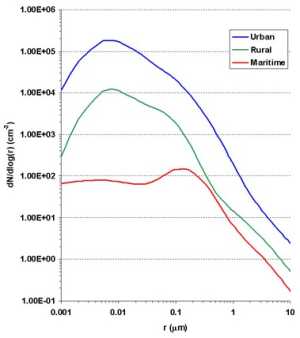|
|
 |
|
|
|
 |
| |
|
|
 |
Clouds & Particles
Basics |
Particles: what do they become?
Once particles are in the atmosphere, transformation, transport and removal can take place. These processes depend on several factors, such as aerosol sizes, concentration and chemical composition, location, meteorological effects... |
|
|
|
|
 |
Aerosol concentration and distribution
Concentration of particles in the atmosphere represents the amount of particles per volume unit. It can be expressed in terms of mass or number per volume unit. It means, it is the mass we would find if we weight all the particles contained in a volume of 1 m3 (1000 litres) or the number of particles if we count them. Anyway, concentrations show great variability for different locations. In remote marine areas, the aerosol mass concentration is around 4.8 µg/m3, a factor of 3 lower than that in nonurban continental areas (15 µg/m3). In cities, particles concentration can exceed 100 µg/m3 or 1 million of particles per cm3! |
 |
 |
|
1. Aerosol concentrations for urban, rural and maritime environments (Data from Jaenicke (1993)).
|
|
 |
The figure on the left shows aerosols distribution for marine, urban and rural environments. Aerosol size distributions describe the number of particles as a function of their radius.
You can observe that the highest number of particles are found in cities (blue line) and most of these particles are very small, less than 0.05 µm in radius.
Generally, the size distribution of urban aerosols is variable. High numbers of small particles are found close to sources, but their concentration decreases rapidly with distance from these sources. |
Transformation mechanisms
Aerosols do not stay indefinitely in the atmosphere: they generally stay in the troposphere during a few days. Hence transformation mechanisms may take place before aerosols are removed. These transformations are coagulation, condensation and cloud processing. They are explained in the unit 2 of "More".
|
Aerosol removal
While airbone, aerosols may have changed physically and chemically. But they do not stay during years in the troposphere : as natural and human sources continuously inject new particles in the air, they have now to disappear, unless we couldn't breath, or see our feet!
The particle removal mechanism is called deposition. Deposition is the word used to say that the only way for a particle to be removed from the atmosphere is to go back to the Earth's surface: it can't disappear by magic! See more details about deposition pathways in the Unit Particles in the "More" section. |
 |
 |
|
2. This figure illustrates the transport of aerosols: look at the pollution swirling above the Atlantic Ocean off the west coast of France (bottom right). At top center is the southern part of the United Kingdom, with Ireland to the west. Source: NASA. Click to enlarge! (68K).
|
|
 |
Of course the bigger the particle is, the less longer it stays in the atmosphere. A large particle falls under gravity (as a small stone you would drop from an elevated place). It falls down with a velocity of several cms per second. That is why bigger particles are only found close to their source. However wind has a key role: look at a feather you drop, it can stay longer in the air if you blow on it! It is the same for particles, even if you don't see them because of their small sizes.
But particles can also travel thousands of kilometers: Saharan dust is sometimes found on the east coasts of South america. |
|
A particulate case: stratospheric aerosols
Usually residence time of aerosols (the average time a particle stay in the atmosphere before beeing deposited) is less than a week. It is not always the case for volcanic particles, as large volcanoes erupt inject amount of ash directly in the upper part of the atmosphere (called stratosphere), under the form of primary aerosols or SO2 gas; SO2 further form secondary aerosols. In the stratosphere, particles are not easily removed and are spread all over the world. Stratospheric aerosols can therefore reside several years! |
 |
 |
|
3. You can see that the Pinatubo plume has begun to reach west coast of Africa in 10 days. Source: NASA. (Click to enlarge, 32 Kb).
|
|
 |
The Pinatubo erupt
After 600 years of silence, Mount Pinatubo in Philippines decided to erupt on June 15, 1991. 20 millions tons of sulfur dioxyde SO2 were injected in the stratosphere. 3 weeks after, SO2 has circled the globe (see image on the left).
|
You can also see here the "Pinatubo effect": Red colour show the highest values, while dark blue shows the lowest values which are normally observed in the stratosphere.
On the first image, stratospheric aerosols before the erupt;
2nd and 3rd images: 1 and 3 months after explosion;
4th image: 2 years after, atmosphere is still perturbed!
|
 |
 |
 |
|
4. Source: NASA
|
|
About this page...
Author: Justine Gourdeau LaMP Clermont ferrand/France. Scientific reviewing: Dr Serge Despiau, LEPI, Toulon, France.
date of generation: 2003-09-04 |
|
 |
|









